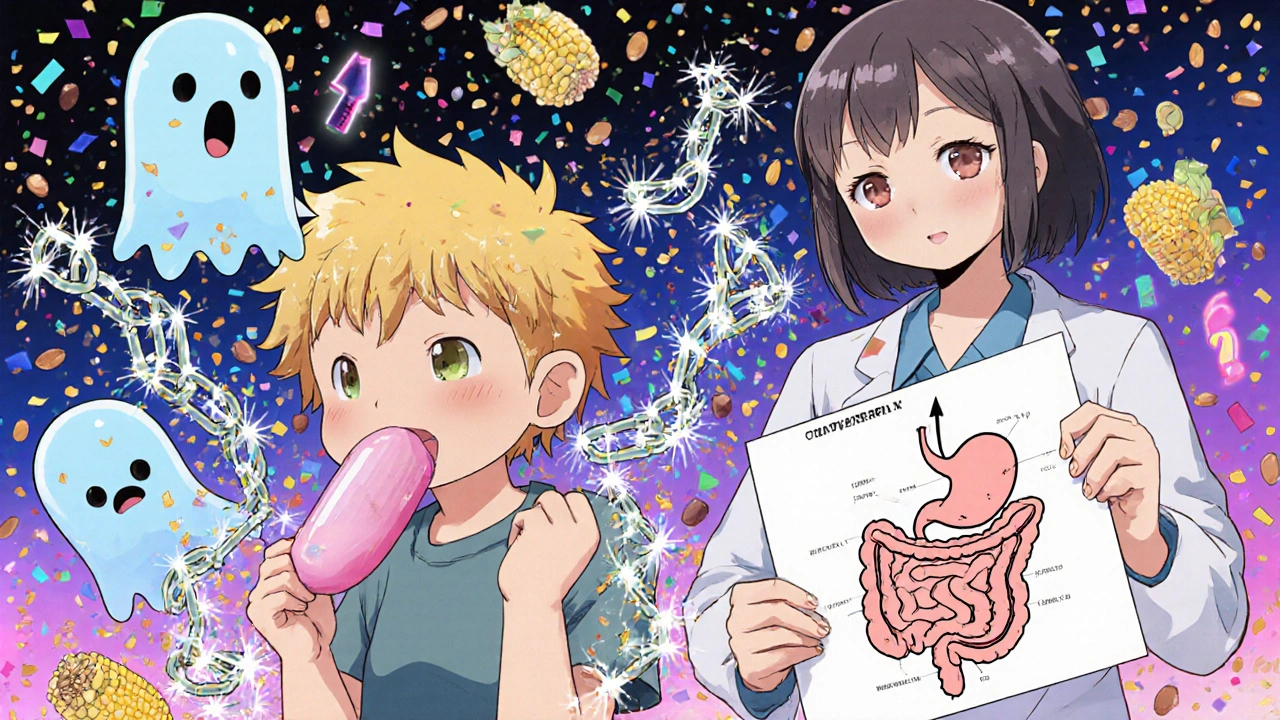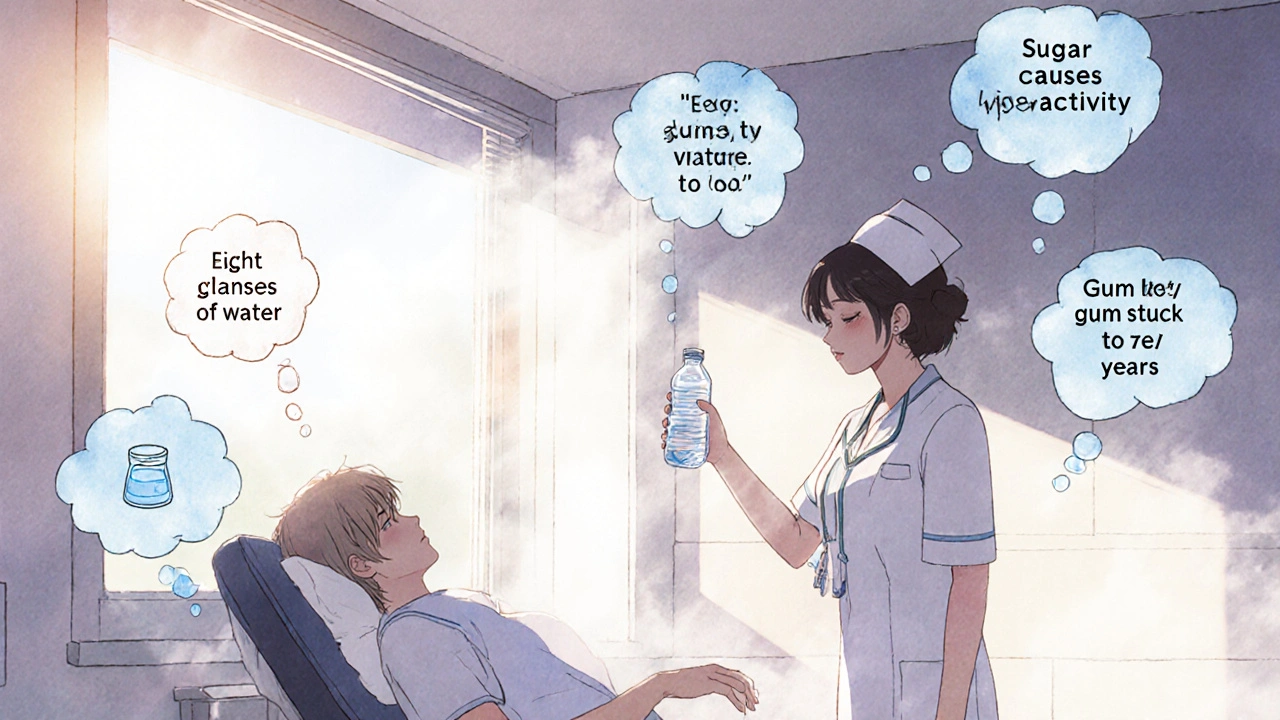How many times have you heard that you need to drink eight glasses of water a day? Or that chewing gum stays in your stomach for seven years? These stories sound harmless-maybe even funny-but when they shape how people care for their health, they become dangerous. In clinics, pharmacies, and homes across the UK and beyond, outdated myths continue to influence decisions about diet, medication, and daily habits. The truth? Most of these ideas have been thoroughly disproven. But that doesn’t stop them from spreading.
Why Do Health Myths Stick Around?
Myths don’t survive because they’re true. They survive because they’re simple, repeated, and often tied to emotions. The idea that sugar makes kids hyperactive? It fits the experience of birthday parties and candy-filled afternoons. The belief that you lose most of your body heat through your head? It’s easy to imagine-your head feels cold when you’re outside without a hat. But feeling something isn’t the same as it being scientifically accurate.
These myths get passed down like family recipes. Grandparents tell them. Teachers repeat them. Even some healthcare workers say them without checking the evidence. A 2022 study by the American Hospital Association found that 68% of hospitals now have formal programs to correct myths in patient education-up from just 12% in 2020. That’s progress. But it also shows how widespread the problem is.
Myth: You Need Eight Glasses of Water a Day
This one is everywhere. Bottled water brands, wellness blogs, even some doctors repeat it. But here’s the truth: there’s no scientific basis for drinking exactly eight glasses of water daily.
Dr. Heinz Valtin, a kidney specialist at Dartmouth Medical School, reviewed over 100 peer-reviewed studies in 2002 and found zero evidence supporting this rule. Your body gets water from food, coffee, tea, milk-even soups. Hydration needs vary based on your size, activity level, climate, and health. Someone working outdoors in Glasgow in winter needs less than a construction worker in Dubai in July.
Thirst is your body’s natural signal. If you’re not thirsty and your urine is pale yellow, you’re likely well-hydrated. Forcing extra water doesn’t improve skin, flush toxins, or boost energy. In fact, drinking too much can be dangerous-leading to low sodium levels, confusion, and even seizures in extreme cases.
Myth: You Lose 70-80% of Your Body Heat Through Your Head
This myth started with a flawed military study in the 1950s where subjects wore Arctic gear but left their heads uncovered. Naturally, their heads felt cold. But that didn’t mean the head lost more heat than other exposed body parts-it just meant it was the only part not covered.
Modern research from UCHealth and the BBC shows the head makes up only about 7-10% of your total body surface area. Heat loss is proportional to exposure. If you go outside barefoot, you lose more heat through your feet. If you wear a hat but no coat, you lose heat through your torso. The head isn’t special-it’s just one part of the puzzle.
Wearing a hat in winter? Great idea. But don’t think it’s the only thing keeping you warm. Layer up. Cover your hands. Protect your neck. Heat loss isn’t about one body part-it’s about how much skin you expose.
Myth: Chewing Gum Stays in Your Stomach for Seven Years
This one terrifies parents. Kids swallow gum? Panic. “It’ll stick in there for years!” But that’s not how digestion works.
Chewing gum isn’t digested-yes, that’s true. Your body can’t break down the synthetic rubber base. But that doesn’t mean it stays put. Dr. Ian Tullberg, a family medicine specialist, confirmed that gum passes through your digestive system just like any other indigestible material-like corn kernels or sesame seeds. It moves through your gut and exits in your stool within two to four days.
There’s only one real risk: swallowing large amounts of gum, especially in young children, which could potentially cause a blockage. But one piece? No problem. The seven-year myth? Pure fiction. And yet, it’s still taught in schools and repeated by well-meaning adults.

Myth: We Only Use 10% of Our Brain
This myth shows up in movies, self-help books, and even some “brain training” apps promising to unlock your hidden 90%. But neuroscience says otherwise.
Functional MRI scans show activity across the entire brain-even during simple tasks like sipping coffee or listening to music. Every part has a role. The idea that we only use a fraction comes from a misquote of psychologist William James in the 1920s. He talked about untapped potential, not unused brain tissue. That got twisted into a literal claim.
Brain injuries prove this. Damage even a small area, and you can lose speech, movement, or memory. If 90% of the brain was unused, we’d be able to survive much worse damage. We don’t. Our brains are fully active, just not all at once. Efficiency, not unused capacity, is what makes us human.
Myth: Superfoods Like Acai and Goji Berries Are Miracle Cures
Walk into any health store and you’ll see jars of goji berries, acai bowls, chia seeds-all labeled “superfoods.” The term sounds scientific, but it’s not. There’s no official definition in nutrition science. It’s a marketing label.
Studies from the European Food Information Council show no evidence that these foods provide health benefits beyond what you get from a balanced diet rich in fruits, vegetables, whole grains, and lean proteins. Blueberries are great. So are apples. Broccoli is just as nutritious as kale. You don’t need to spend £15 on acai packs when you can buy local berries for £3.
What’s more dangerous is when people replace proven treatments with expensive “superfood” supplements. Someone with high blood pressure might skip their medication because they’re drinking green tea every morning. That’s not wellness-it’s risk.
Myth: Sugar Causes Hyperactivity in Children
Parents swear it: after Halloween, the kids are wild. Sugar must be the cause. But over 23 double-blind studies, including a major 2021 meta-analysis in JAMA Pediatrics, have found no link between sugar intake and hyperactivity in children.
So why does it feel true? Because context matters. Birthday parties, holidays, excitement-those are what make kids act up. Sugar is just along for the ride. The myth persists because it’s convenient. It lets parents blame a single substance instead of dealing with overstimulation, lack of sleep, or inconsistent routines.
Even worse? The sugar industry spent decades funding research and lobbying to keep this myth alive. Documents from the 1990s show industry groups actively promoted the idea to shift blame away from processed foods. It worked. The myth still thrives.
How to Spot a Health Myth
Not all myths are obvious. Some sound plausible. Others come from trusted sources. Here’s how to tell the difference:
- Check the source: Is it a peer-reviewed journal, a hospital, or a government health site? Or is it a blog, a social media influencer, or a product ad?
- Look for numbers: Real science uses data. “Studies show” isn’t enough. Ask: Which studies? When? Who funded them?
- Watch for absolutes: “Always,” “never,” “miracle cure,” “secret truth”-these are red flags. Biology is messy. Health advice rarely has one-size-fits-all answers.
- Ask: Does this make sense? If it sounds too good to be true, it probably is. Your body doesn’t need magic pills to detox. It has a liver and kidneys for that.
What Works: The Truth Sandwich
Just saying “that’s wrong” often backfires. People double down when they feel attacked. The best way to correct a myth? Use the “truth sandwich.”
Start with the truth: “Your body gets hydrated from many sources, not just water.”
Then briefly name the myth, clearly labeled: “Some people think you need eight glasses a day, but that’s not based on science.”
Then end with the truth again: “Drink when you’re thirsty. Watch your urine color. That’s the real guide.”
Research from the American Association for the Advancement of Science shows this method improves retention by 47% compared to just saying “no, that’s false.” It avoids triggering defensiveness while reinforcing accurate information.
What’s Next for Patient Education?
Hospitals and clinics are starting to take myth-busting seriously. The World Health Organization’s Myth Busters initiative has corrected over 2,300 myths across 187 countries. Google’s “About This Result” feature now shows context for search results, helping people spot unreliable health claims before they click.
But the real change happens in conversations. When a nurse explains why a myth is wrong-not with a lecture, but with a calm, clear, evidence-based answer-patients remember. They trust. They follow advice better. One study found patient adherence to medical plans increased by 31% when myths were addressed directly.
Myths won’t disappear overnight. But with better education, better tools, and better communication, we can stop letting fiction shape health decisions. You don’t need to be a scientist to spot a myth. You just need to ask: “Where’s the proof?”
Is it true that you need to drink eight glasses of water every day?
No, there’s no scientific evidence that you need exactly eight glasses of water a day. Your hydration needs depend on your body size, activity level, climate, and diet. You get water from food, tea, coffee, and other drinks. Thirst and urine color are better guides than a fixed number.
Does chewing gum stay in your stomach for seven years?
No. While your body can’t digest the gum base, it passes through your digestive system like other indigestible items-such as corn or seeds-and exits within two to four days. Swallowing a single piece is harmless.
Do superfoods like acai and goji berries offer unique health benefits?
No. The term “superfood” is a marketing label, not a scientific one. While these foods are nutritious, they offer no special benefits beyond what you get from a balanced diet of fruits, vegetables, and whole grains. Local, affordable produce works just as well.
Does sugar make children hyperactive?
No. More than 20 controlled studies, including a major 2021 review in JAMA Pediatrics, found no link between sugar intake and hyperactivity in children. The excitement around parties or events, not sugar, is what causes the behavior.
Can you really only use 10% of your brain?
No. Brain imaging shows activity across the entire brain, even during simple tasks. The 10% myth comes from a misinterpretation of early 20th-century psychology. Damage to any brain area can cause serious effects-proving all parts are functional.
Why do health myths spread so easily?
Myths stick because they’re simple, emotionally satisfying, and often repeated by trusted sources. They fit into stories we already believe. Even when proven false, they survive if they align with cultural habits, commercial interests, or personal experiences.
What to Do Next
Don’t just accept what you hear. Ask questions. Check sources. Talk to your pharmacist or GP if you’re unsure about something you read online. If you’re a parent, teacher, or caregiver, correct myths gently-especially when they affect children’s health.
Next time someone says, “I heard you need to drink eight glasses of water,” respond with: “Actually, that’s a myth. Your body tells you when it needs water.” Simple. Clear. Powerful.


 Medications
Medications